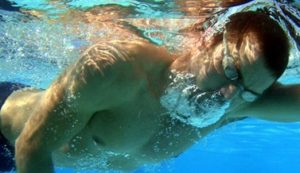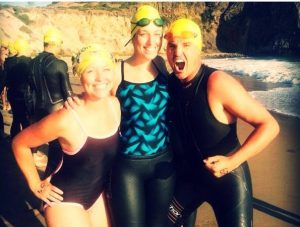Four Breathing Tips to Beat Your Triathlon Swim
September 24, 2015 7:33 pm / Category: Triathlon

I should have expected it, though. I treat many triathletes as a physical therapist at Rausch Physical Therapy & Sports Performance, so I’m familiar with the triathlon-newbies’ popular slogan: “I just really hate the swim portion.” When I used to ask why (I stopped after last summers’ brush with death) I would hear everything from “I can’t breathe,” to “I just get fatigued so quickly.” Even, “I can zone out when I run, but I just focus on not drowning when I swim.”
It’s comforting to recognize that most swimmers (even Olympians… even awesome physical therapists!) have felt that way during the swim at one time or another. However, there are plenty of tips and tricks out there to help calm those fears and get you those swimming PRs.
Four Breathing Tricks for Conquering “The Swim”
Here are my top four training tips that focus on the most important part of swim: breathing! Note that depending on the type of swimming you’re doing (distance, sprints, open water, etc.) your breathing technique is going to have to change.
Tip #1: Be odd
To ensure you train your body to breathe out both sides, try taking a breath every three strokes (when starting, then try every five if comfortable.) This not only allows you to scan the competition around you, but it also helps you avoid injuries to the neck/shoulder and impingement within the shoulder complex that can occur with repetitive, one-sided cervical spine rotation and repetitive overhead reaching. Of course, in situations that require you to take more frequent breaths, such as rough water or fatigue, go ahead and breathe on one side.
Tip #2: Channel your inner fish
When swimming, don’t lift your entire head out of the water to breathe. Instead, do a rotation with your head parallel to the top layer of water, coupled with a small, quick inhalation. You’ll look like a fish gasping for air. Most competitive swimmers use this “fish mouth” technique, but again you may have to switch it up once you hit open water and conditions change. In certain situations, you may have to actually rotate your body more to accommodate, and that’s okay!

Tip #3: Get nosey
People tend to overthink the breath, which can throw off your timing further. Blowing air out of your nose rather than your mouth while submerged will help your timing, especially once you add in the stroke and kicking aspects. Make sure to expel ALL of your air when underwater and to inhale fresh air during each breath.
Tip #4: Practice makes perfect
Make sure to practice your breathing techniques (preferably in a pool) before you even attempt to add the stroke, kick and endurance aspects of the sport. Your body obviously needs oxygen to function, so it’s the first thing you have to master before you can successfully add swimming to your resume. Check out master swim classes or, if you have access, a SwimLabs facility to help assess breathing mechanics.
Below you’ll find a few video tutorials to help illustrate some great breathing tips; some are more laid back while others are more technical, but I think each highlights some basic points that can help beginner/intermediate level swimmers. Even those of us who haven’t been in competition mode for years can benefit from brushing up on our breathing basics; I definitely will before my next attempt to conquer the ocean swim.
[framedbox]Additional Links and Sources:
- Aaron Lawson Video – Helpful Tips on How to Swim
- Swim Art Video – Breathing Skills For Open Water Swimming
- SwimLabs Video – Swimming Freestyle 101: Balanced Breathing[/framedbox]

Lyndsay DeFilippo PT, DPT, CKTP received her Doctorate of Physical Therapy from New York University in 2010. She’s a Graston Practitioner and a Certified Kinesiotaping Practitioner. Lyndsay looks at each injury as a constantly changing puzzle, which is only solved when her patient returns to what s/he loves doing. She enjoys helping with the full recovery process, which includes providing the education, tools and fundamentals to prevent re-injury and the potential for new injuries.



